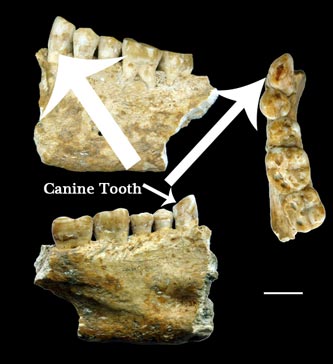Stone Age Toothache Eased by Beeswax Filling
A trip to the dentist may be regarded by many as one of the perils of modern-day living but surprisingly there is a considerable amount of fossil evidence to suggest that Stone Age people may have practised some rudimentary dentistry. Scientists using a partial human jawbone that had been found in Slovenia more than one hundred years ago, got a surprise when they used this specimen to test a new X-ray imaging machine. The researchers discovered something remarkable in a canine tooth, the tooth had a long, vertical crack down it and an area of the crown, the enamel, had been worn away to reveal a large cavity. A broken and worn tooth of an ancient human is not a surprise, after all, teeth were worn down by the harsh and abrasive diet endured by our ancestors. However, this particular tooth, showed signs that somebody had attempted to give the tooth a filling. Could this be evidence of Neolithic dentists?
Neolithic Dentists
A plug of material had been carefully applied to the hole, covering the sensitive dentine and filling the cavity. The material, once analysed using infrared spectroscopy was identified as beeswax and remarkably the filling was over six and a half thousand years old. This suggests that either the owner of the tooth or another member of the tribe has plugged the worn tooth either whilst the owner was still alive or shortly after the person died. If the tooth was repaired when the person was alive, then this is one of the oldest examples of Stone Age dentistry found to date.
A Picture Showing Various Images of the Tooth and the Human Jawbone
Picture credit: Journal PLoS One
This example of Neolithic dentistry is not an isolated case, American researchers reported back in 2001 of evidence of flint drills being used to make holes in teeth from people that lived between 9,000 and 7,500 years ago in Pakistan. However, none of these drilled teeth showed any signs of having received a filling – but why beeswax?
Beeswax and Propolis
Beeswax and a substance called Propolis are used extensively in herbal medicines today. Propolis is a natural, brown, sticky substance that is collected by honey bees from trees and other plants. It contains a mixture of plant resin, waxes and essential oils. Just like that other product of the honey bee – honey, these substances have anti-bacterial and anti-inflammatory properties. Beeswax crammed into a tooth cavity might have eased any toothache to some degree and helped to prevent infections. Beeswax also has the added advantage of having a low melting point so it can be easily worked. At body temperature the waxy esters and other long chain molecules solidify and make a strong, stable bond, effectively providing a strong cap for the hole in the tooth.
It seems our ancient ancestors may have known a thing or too about dental hygiene. The fossil human jawbone was found in a cave system, near the town of Lonche in what is now Slovenia today. It is believed the jawbone is from an adult male who was aged between 24 and 30 years old when he died.
A Remarkable Discovery
The scientists who made this remarkable discovery, Claudio Tuniz and his colleague Federico Bernardini at the International Centre for Theoretical Physics based in Trieste, cannot be certain that the tooth filling was not applied post mortem. There is some evidence in the fossil record of human teeth have been treated as part of burial ceremonies as corpses are prepared for the afterlife. If this is an example of early dentistry, helping a patient overcome the pain from a toothache then this practice did not die out at the end of the Stone Age. Beeswax and other materials were used in ancient Egypt to help with a variety of ailments, these substances also had important roles to play in the Egyptian mummification process – helping to preserve soft tissue.
What is intriguing is that other teeth in the ancient human jaw bone used to test the X-ray machine had cavities as well, but only the canine tooth was filled. Perhaps this tooth was particularly troublesome, or perhaps if the prices paid today for dental work reflect the price paid in the Neolithic for such treatment our Stone Age patient could not afford any more dental work. Of course this is pure speculation, one other point to note is that was the treatment self administered or was there a special person in the tribe, perhaps a shaman or wise elder who was tasked with looking after the health and well-being of other tribe members?






Leave A Comment